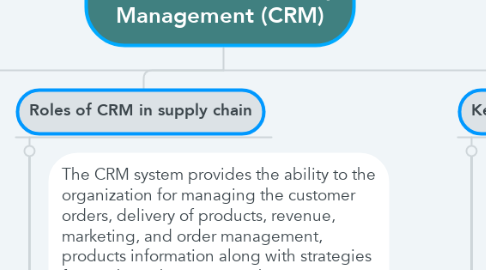
1. Define CRM
1.1. A concept that refer to the strategies used by an organization to improve business relationship with customer.
2. Roles of CRM in supply chain
2.1. The CRM system provides the ability to the organization for managing the customer orders, delivery of products, revenue, marketing, and order management, products information along with strategies for reaching the target market.
2.2. The CRM ensures good customer relationship as the right product for the right customer at the right time in right quantity, condition, and cost.
2.3. The CRM segments the each of the customer needs and supports the relationship marketing or cross selling.
2.4. Steps to design and implement a successful CRM program :
2.4.1. Step 1 : (Creating the CRM plan) - Integration or replacement of existing legacy systems - The costs and time frame for implementation
2.4.2. Step 2 : (Involve CRM users from outset) - Employees need to understand how the CRM initiatives effect their job before they will by into the program.
2.4.3. Step 3 : (Select the right application and provider) - Finding the best application and supplier can be accomplished a number of ways including visit trade show, read trade literature, hire consultant, etc.
2.4.4. Step 4 : (Integrate existing CRM applications) - CRM systems are not one single product, but rather a suite of various application that have been implemented over time. - Compatible CRM modules are needed that are linked to one centralized database or data warehouse containing all customer information.
2.4.5. Step 5 : (Establish performance measures) - Performance measure linked to CRM system objective allow users to witness the progression of the system in meeting its original objectives.
2.4.6. Step 6 : (Providing CRM training for all users) - Provide and require training for all of the initial users and then provide training on an ongoing basis as applications are added. - Help convince key users likes sales and call center.
